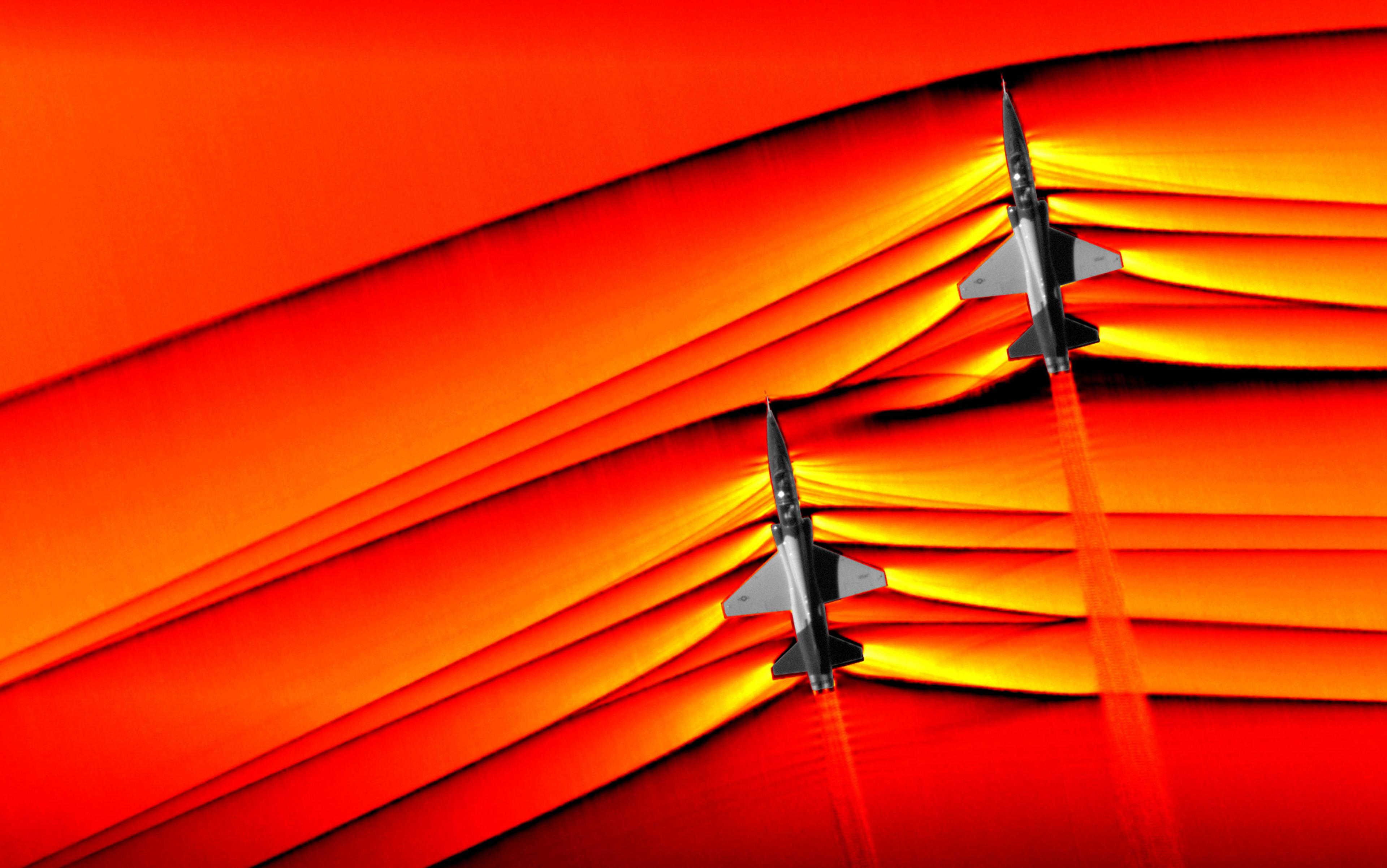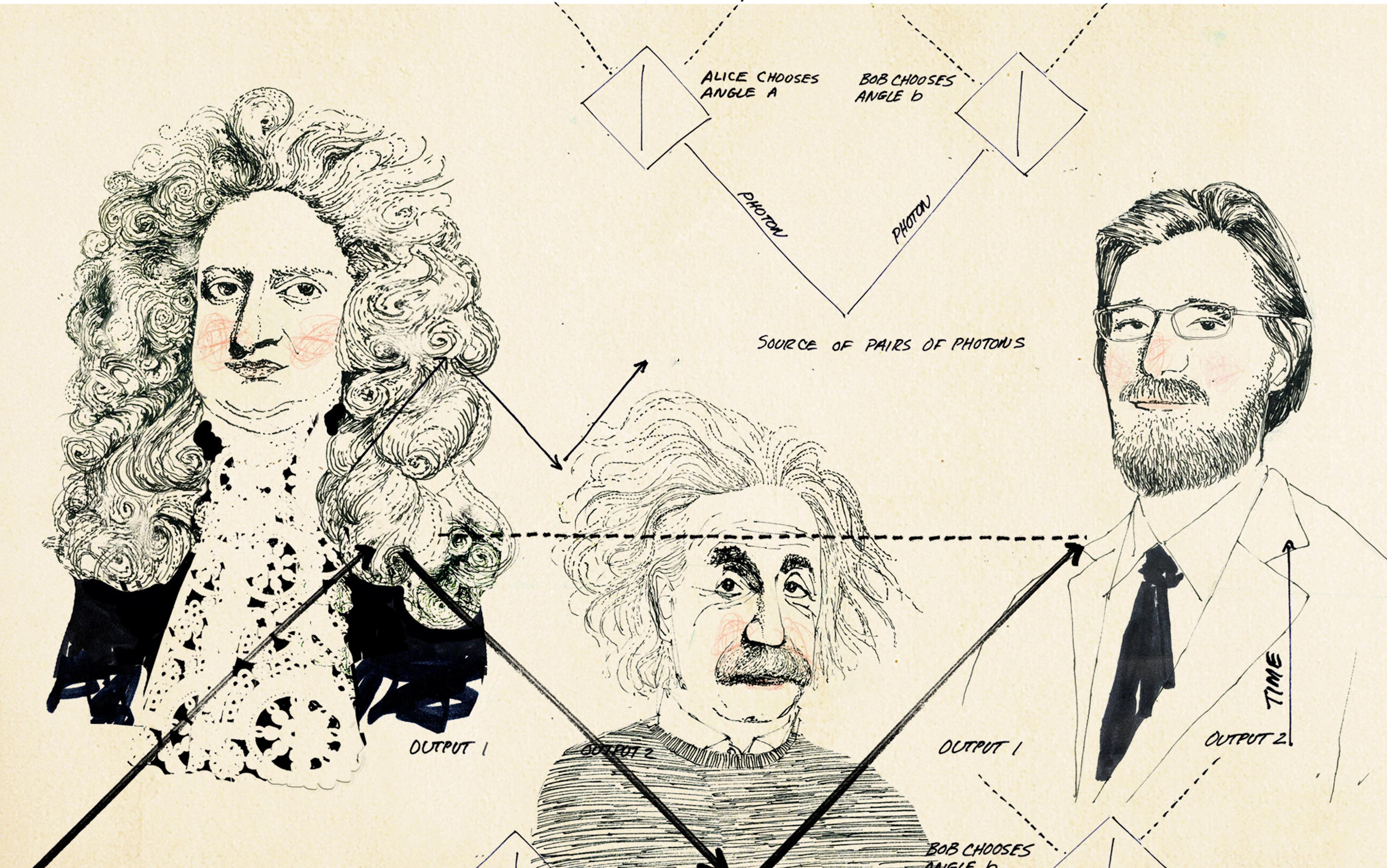Ronnie O’Sullivan is an absurdly talented snooker player. When it suits him, the English five-times world champion can switch from playing right-handed to left-handed, and has even hit competition shots one-handed. But can he play snooker backwards in time? Of course he can’t. Why not? Well, there’s nothing particularly special about O’Sullivan, nor about snooker, in this respect. Think of any familiar process in our ordinary past-to-future direction, then play it backwards, and you’re faced with bizarre, improbable scenarios. With time flipped, we see a world in which shards of glass spontaneously jump off the floor into smooth wineglasses, cars suck carbon dioxide out of the air while moving backwards, and the surface of each Phil Collins LP is slowly smoothed out until no record of his music remains. As desirable as each of these processes might be, they appear not to describe the world in which we live.
Instead, we are very much ingrained in thinking that time goes from past to future; that there is something important about the world that past-to-future descriptions get right and future-to-past descriptions get wrong. Even though the Universe is expanding relative to the past-to-future direction, and contracting relative to the future-to-past direction, we nonetheless take it for granted that ‘really’ the Universe expands and does not contract. This idea of time going from past to future underlies much of our wider philosophical thinking about the nature of reality: we think of the past history of the world as fixed but of the future as undecided and open to a wealth of possibilities; we think that the way things are now depends on how they were in the past, but not on how they are in the future; we think of the laws of nature as telling the Universe how to evolve from earlier to later, and not later to earlier. And so on.
There are many different ways in which time might be thought to ‘have a direction’ but, to keep things simple, let’s work with the following idea: if time has a direction, then presumably it could have had the opposite direction; a universe just like this one but with the opposite direction of time would constitute a different universe to our own. Perhaps it is even possible that, contrary to our beliefs, our world actually runs from future to past. Such a backwards-in-time world, replete with its unlikely and unfamiliar processes, would surely be fundamentally unlike the one in which we think we live, and so our ordinary beliefs about time would be wildly mistaken. This is exactly what my preferred theory of time – what I call the ‘C-theory’ – rejects. According to the C-theory of time, it is not possible for this Universe to have run in the opposite direction of time, for there is no such thing as ‘the direction of time’ that could be reversed. This is the theory of time that I think fits best with our scientific understanding of the world. But before I can convince you, let’s first go through the ABCs of the philosophy of time.
It is common to think that time is special in a way that space is not. Though space is fixed, time is often said to ‘flow’ or ‘pass’. And though we don’t think there’s anything inherently special about where we are in space, we do think there is something special about the ‘now’, where we are located in time. As the now moves forwards in time, once-future things undergo a process of ‘becoming’ present and then past. In philosophy-of-time jargon, this set of views is known as the ‘A-theory of time’, based on the distinction made in 1908 by J M E McTaggart, a philosopher at the University of Cambridge.
McTaggart was interested in two different ways in which we standardly represent time. First, the ‘A series’ represents time as carved up into a growing past, a moving, flowing present, and a shrinking future. Secondly, the ‘B series’ represents time as a bunch of moments spread out in a fixed, unchanging series from earlier to later. Whereas old-style calendars give a B-series representation of time with equal emphasis for all the days of the month, your smartphone calendar gives something closer to an A-series representation, always highlighting the present day as special and updating itself as time passes. Accordingly, the B-theory of time holds, contrary to the A-theory, that time does not flow or pass, preferring the so-called ‘block universe’ model of time, where the universe is a four-dimensional entity, with events and entire lives strung out along the time dimension, with no points in time distinguished as past, present or future, much like our wall-mounted calendars, only with all of time on an equal footing, not just this month.
Many, including McTaggart, have rejected the B-theory as too impoverished to account for time; it fails to represent, they say, the special and dynamic nature of the present moment. Depending on your age, you might be looking forward to your next birthday with excitement or trepidation, which grows exponentially as the future birthday draws closer to the present. Likewise, previous birthdays don’t evoke the same kinds of excitement or anxiety – they have been and gone. It is very simple to explain this by holding that time really does pass, and that your birthday really does go through a process of becoming present and then past.
We are not making contact with some deep temporal arrow that could have pointed the opposite way
But there are good reasons to pass up the A-theory’s extra structure here, chief among them being the fact that physical theories afford no special place for the passage of time. The equations of classical and quantum physics contain no variable corresponding to which time is ‘now’, nor is there an equation describing how such a thing ‘moves’ in time, and no one thinks that there’s a serious question about how fast it does so. As such, philosophers and physicists have, for the most part, embraced the block universe: the German mathematician Hermann Weyl in 1949 remarked that ‘[t]he objective world simply is, it does not happen’. Meanwhile, Albert Einstein in 1955 consoled the bereaved family of his friend Michele Besso with the observation that, for those ‘who believe in physics, the distinction between past, present and future is only a stubbornly persistent illusion’.
If one wishes to hold that time really passes, one has to accept the awkward fact that physics has done pretty well without making use of such a concept. Instead, the B-theory takes our beliefs about the passage of time to be compatible with the absence of such a thing from the basic furniture of reality. For the B-theorist, though it might appear to you as though your birthday underwent some process of ‘happening’, this is due to something about how we experience and represent our own trajectory through time, rather than some objective process that the birthday itself underwent.
The C-theory of time goes a significant step further even than the B-theory: not only does it reject the passage of time, it also rejects the directionality of time. Though McTaggart’s B series lacks a distinction between past, present and future, it is directed in that times are ordered from ‘earlier’ to ‘later’. In contrast, McTaggart’s lesser-known C series, on which the C-theory is based, ‘determines the order’ but ‘does not determine the direction’ of moments of time. According to the C-theory, when we describe a process as ‘going’ or ‘running’ or ‘evolving’ from earlier to later, we are not making contact with some deep temporal arrow that could have pointed the opposite way.
A consequence of this is that if we were to describe the world in reverse, we would not be getting anything about time wrong. As the cosmologist Thomas Gold put it in 1966, when we describe our world in the unfamiliar future-to-past direction, we are ‘not describing another universe, or how [this Universe] might be but isn’t, but [are] describing the very same thing’. Likewise, the philosopher of science Hans Reichenbach suggested in 1956 when reflecting on time in classical physics that ‘positive and negative time supply equivalent descriptions, and it would be meaningless to ask which of the two descriptions is true’. Though it no doubt sounds weird to describe things backwards in time, this weirdness is due to our unfamiliarity with the future-to-past perspective.
So while the B- and C-theories agree that we live in a block universe, the C-theory goes further in holding that this block doesn’t come equipped with a temporal arrow. Whereas the block universe has become very much the default way to understand the physical world, the C-theory’s adirectional universe remains highly contentious. On the one hand, the fundamental physical theories are symmetric with respect to time. The laws of classical and quantum mechanics and of relativity theory are time-reversal invariant – this means that, if we were to describe the world purely in terms of classical or quantum particles, the laws of physics tell us that any process that could happen in one direction of time could also happen in the other direction, meaning that processes in such a description are reversible.
The kinds of processes we ordinarily think of as irreversible, such as breaking wine glasses or the existence of Phil Collins’s music, turn out to be reversible if looked at in fine enough detail, in molecular terms. Moreover, the laws of physics are characterised by equations that allow us to predict the future and ‘retrodict’ (the past-directed analogue of ‘predict’) the past in equal measure, meaning that there is no sense that the laws of physics describe or govern the world from past to future any more than from future to past. So far, so good for the C-theory.
But on the other hand, physics standardly makes use of a wealth of time-directed ways of representing the world. Physical processes are pictured as running in a particular direction, and this affects the way we talk about the properties of such processes. When describing something as mundane as the motion of a particle, classical mechanics attributes it a velocity, a vectorial quantity that tells us the direction in which that particle is moving. And yet it is simple to see that, if the particle is moving from left to right in our past-to-future direction, it is equivalently moving from right to left in the future-to-past direction, meaning that even textbook classical physics requires us to make assumptions about the time-directedness of everyday processes.
If the world is not directed in time, why is it so useful to talk as if things run in a preferred direction?
More generally, physics favours a past-to-future mode of describing the Universe: it expands rather than contracts; it evolved from some set of initial conditions 13.7 billion years ago, and not from some future set of conditions; matter collapses into black holes and is not spewed out by white holes; entropy increases over time and does not decrease. It seems that we take for granted that the very world physics aims to describe is past-to-future directed.
So here lies a puzzle. Regardless of whether the physics is insensitive to the direction of time, our past-to-future ways of representing the world are so familiar and ubiquitous that one might think that only a pedantic, tiresome philosopher would bother trying to insist that such a picture doesn’t ‘really’ correspond to reality. Surely it’s not ‘equally true’ to say of our Universe that it is contracting, or that biological species are undergoing some process of ‘de-evolution’ to the primordial slime, or that we’re getting younger?
As the English astronomer Arthur Stanley Eddington remarked in 1927: ‘If you genuinely believe that a contra-evolutionary theory is just as true and as significant as an evolutionary theory, surely it is time that a protest should be made against the entirely one-sided version currently taught.’ In other words, if the world is not directed in time, then why is it so useful to talk as though things run in a preferred direction in time? What we want from the C-theory is the best of both worlds: an adirectional theory of time that respects the underlying lack of time-direction in physics, but one that makes sense of our ordinary preference for describing things from past to future. Can the C-theory solve our puzzle?
Suppose for the sake of argument that all the processes in our world actually run in the opposite direction to what we ordinarily think; that ‘tomorrow’ is earlier than today; that the cars on the motorway are moving ‘backwards’; and that we are, contrary to our beliefs, getting younger daily. The natural response, I think, would be something like: ‘So what?’ So what if I am ‘really’ getting younger if all the available evidence has (albeit erroneously) led me to believe and feel that I am getting older? So what if the Universe is ‘really’ contracting if our standard use and interpretation of cosmological data leads us to believe that it is expanding? At some level, it might be reassuring to believe that Phil Collins’s back catalogue is really being unwritten – but if it makes no difference to my actual auditory experience, then so what? It becomes absurd to worry if the world is ‘really’ directed toward ‘the past’, which suggests that such worries are borne out of a bad theory of time. It is exactly through removing this worry that the C-theory solves our puzzle, as I argued in 2016.
When I’m watching snooker, I take for granted that O’Sullivan is playing ‘forwards in time’. But what informs my judgment? When O’Sullivan strikes the cue ball into the black ball, potting it into the corner, I can make sense of the past-to-future description of the process because it better accords with my judgments about the causal processes involved. From past-to-future, we see:
(1) a cue ball being struck by a snooker player towards a motionless black ball;
(2) the cue ball striking the black ball, transferring most of its momentum to the black ball, and resulting in outgoing soundwaves from the collision;
(3) the black ball dropping into the corner pocket and coming to rest.
If we were to run a video of this in reverse, we’d get the future-to-past version:
(1*) the pocket begins to jiggle until it forces the black ball to jump up onto the table, accelerating towards the cue ball;
(2*) the black ball strikes the cue ball at the same time as inwards-radiating soundwaves concentrate on the collision, resulting in the cue ball moving towards the snooker cue with greater momentum than that of the black ball;
(3*) the cue ball collides with the snooker cue causing the snooker player’s arm to move away from the table.
If we think of the past-to-future and future-to-past descriptions as telling us about different possible processes, we run into a problem. Whereas the past-to-future description seems to get the causal facts right, the future-to-past description seems to get them wrong. But why? There are two key things here that stand out. First, the future-to-past description seems not to respect the fact that O’Sullivan is in control of his shot. Rather, from future to past, his actions come after, seemingly as a result of, the balls’ motion. Secondly, the future-to-past description describes a series of inexplicable coincidences: the pocket just happens to jiggle in just the right way to propel the black ball upwards and along the surface of the table, and the inverse soundwaves just happen to coincide with the collision of the black and cue balls. Whereas the future-to-past description is just about intelligible, we have a clear preference for the past-to-future description due to it respecting both our ordinary judgments about O’Sullivan’s control over the snooker balls and their likely movements.
Think of the Universe as a great cosmic snooker game (only without a great cosmic O’Sullivan)
But here’s the key thing: these considerations about control and likeliness apply independently of the direction of time. Regardless of whether I show you the video of O’Sullivan’s shot forwards (past-to-future) or in reverse (future-to-past), I expect you to ultimately make the same causal judgments, namely that the video represents O’Sullivan potting the black ball into the corner, and not the reverse causal process. The key philosophical step made by the C-theory is that these causal judgments play a central role in defining and constituting the direction of time. There is, for the C-theorist, a direction of time only if there exist in nature the right kinds of patterns that make it useful for us to think in terms of an arrow of cause and effect. If we are happy to say that in a world without such patterns there would be no direction of time, then we can get rid of the question Could the world really be running from future to past?
This line of reasoning applies much more generally – we can think of the Universe as a great cosmic snooker game (only, presumably, without a great cosmic O’Sullivan). When considering the second law of thermodynamics – why entropy tends to increase over time rather than decrease or, more generally, why temperatures equalise over time, gases spread out, and steam engines lose useful energy to heat – Reichenbach stressed that ‘it has no meaning to say … that … entropy “really” goes up, or that its time direction is “really” positive’. His point is that we should take thermal processes themselves to define the direction of time; it is just more useful and simple to describe the Universe from lower to higher entropy, but this doesn’t mean that ‘really’ the Universe runs in a preferred time direction.
The second law is enormous in scope, describing pretty much all the ordinary irreversible processes in our everyday lives that lead us to think of time as directed, from the smashing of glasses to the creation of Phil Collins records. What we learn from the C-theory is that, though there is something very important about these widespread irreversible processes that makes the world look very different towards the future than it does towards the past, we should not mistake this for a deeper property of time. It would ultimately be misguided to ask why we live in a world where entropy increases rather than one where it decreases.
To return to our original problem: is the world directed in time? The C-theory gives a complex and pleasingly paradoxical answer. On the one hand, it would be unreasonable to worry whether the world were ‘really’, contrary to our beliefs, running from future to past. But on the other hand, this is precisely because there is no such thing as a ‘direction of time’ that could be pointing the wrong way in the first place.






